fountain - A fountain is a sculpture, typically decorative, featuring one or more jets or flowing streams of water, emerging from and into a pool or lake, often churning or splashing. Fountains require either a naturally flowing (gravitational) stream of water or one that is driven by a motorized pump.
Architects, among others, often refer to a fountain as a water feature, a category of environmental subjects (often in landscape architecture) which might include any natural or artificial body of water, whether still or moving. Associations include: rain, puddles, streams, rivers, waterfalls, geysers, ponds, lakes, oceans, vessels, reservoirs, tanks, cisterns, buckets, ewers, showers, squirtguns, sprinklers, misters, vapors, waves, bubbles, foam, evaporation, pipes, hoses, valves, pumps, drains, waterslides, bridges, fish, boats, seaweed, reflections, rainbows, etc.
People seem compelled to throw coins into fountains, and take for granted that they will be collected for charitable purposes.
There are many things to consider that might help to determine the form of a fountain. Certain practical issues will affect choice of materials used in a fountain, and in the techniques employed in its construction. The water involved forces a designer to anticipate certain issues:
A fountain's structure and its water invariably require regular maintenance. Keeping it clean typicaly requires the use of a filtration system, along with such chemicals as chlorine to remove bacteria, algae, etc. Other chemicals are used to maintain an even pH balance. Technical and material assistance with such issues is likely to be available from people who build or maintain plumbing, irrigation systems, swimming pools, etc., or produce or sell the supplies for such technologies.
Examples:

Spain, 12th century, Lion-shaped Fountain Head, copper alloy, cast and engraved, Louvre. See Islamic art.

Jean Goujon (French, c. 1510 - c. 1565), Nymph and Putto, Paris, c. 1547-1549, stone relief, 0.73 x 1.95 x 0.13 m, from the Fountain of the lnnocents, Paris, Louvre. See bas-relief.

Nicolas Poussin (French, 1594-1665), Venus at the Fountain, pen and brown ink, brown and grey wash, 0.255 x 0.232 m, Louvre. See French art and Neoclassicism.


Francois Duquesnoy (Franco-Flemish, 1597-1643), a Baroque sculptor, Manneken Pis, cast bronze fountain sculpture depicting a nude little boy urinating into the fountain's stone basin, the figure is several inches tall, Brussels, Belgium. Brussels is located in what is historically the Duchy of Brabant. A legend explains the origins of the fountain: In 1142, with the Duke of Brabant only two years old, Brabant's troops were battling its enemies. To encourage them the troops put the duke in a basket which they hung in a tree. From there, the little boy urinated on the enemy troops, who eventually lost the battle. This fountain has long been Brussels' most famous landmark. Make a virtual visit to the fountain.
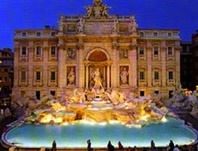
Nicola Salvi (Italian, 1697-1751), Trevi Fountain (Fontana di Trevi) (see two much closer and larger views: at night and at day), 1732-1762, Rome. This is the largest, most ambitious, and most famous of the great Baroque fountains of Rome. The allegorical theme of this sculptural ensemble is the taming of the waters. Tumbling about, water and stonework appear as a lively stage set, turning the small square that surrounds it into something like a theater. The fountain is set against the back of the Palazzo Poli, which was given a new facade of Corinthian columns that link the two main stories, and flank a triumphant arch with a large niche representing the palace of Neptune. In the central niche is Neptune, the sea god, riding a winged chariot guided by tritons through the gushing waters. The chariot is drawn by winged horses, led by a pair of tritons. The Trevi Fountain sits at the end of the Aqua Vergine, one of the ancient aqueducts which supplied water to Rome. Now it supplies the fountain's water. Pope Clement XII commissioned Salvi to design the fountain in 1730. Work on it was completed in 1762. It is called the Trevi because its position at the intersection of three streets — tre vie. There is a frequently cited legend that if you throw a coin over your shoulder into the fountain, your return to Rome is guaranteed.
The garden fountains of the Palace of Versailles near Paris.
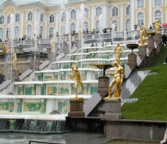
St. Petersberg, Russia, The Staircase and Atlas Fountains at Peterhoff, 18th century, the summer palace of Czar Peter the Great (1672-1725). See an article about the Peterhoff and its fountains.
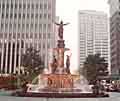
August von Kreling (German, Nuremberg, 1819-1876), Tyler Davidson Fountain, 1870, bronze, height 43 feet, Cincinnati, OH. Cast at the Royal Bavarian Foundry in Munich, the fountain contains thirteen allegorical figures and four bas-reliefs depicting the importance of water to our lives. The central figure is an allegorical figure of the Genius of Water. She stands with arms outstretched showering water from the palms of her hands. Kreling actually designed the fountain in the 1840s for King Ludwig I of Bavaria, but it was not executed until a traveling American businessman, Henry Probasco saw the sketches and commissioned the piece in 1870 as a gift to Cincinnati, and a suitable memorial to his deceased brother-in-law and business partner Tyler Davidson. See foundry.

Geneva, Switzerland, The Jet d'Eau (water-jet), first installed 1886, water was jetted to an altitude of 30 m, but since 1951 can reach 140 m. Situated at the point where Lake Geneva empties into the Rhone River, it is visible throughout the city and from the air, even when flying over Geneva at an altitude of 10 km. 500 liters of water per second are forced by two groups of pumps, operating on 2,400 V electricity with a total power of 1000 kW. The water leaves the nozzle at a speed of 200 km/h. When it is in operation, at any given moment, there are about 2,000 liters of water in the air. Since 2003, the fountain operates during the day all year round, except in case of frost. In addition, it also operates in the evening between spring and fall and is lit by a set of 12 lights.
![]()

![]()
The Trafalgar Square fountain, London.
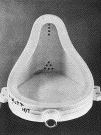
Marcel Duchamp (French-American, 1887-1968), Fountain, 1917, white glazed ceramic plumbing fixture and painted signature, readymade porcelain urinal on its back, 63 x 48 x 35 cm. The urinal, purchased from "Mott Works" company in New York and signed "R. Mutt," was submitted to the jury-free 1917 Independents exhibition, as a sculpture titled Fountain. It was rejected by the hanging committee. This is a photograph of either the second version of 1951 or the third of 1964. The Georges Pompidou Centre in Paris publishes a color photo of it. See anti-art and Dada.

Naum Gabo (worked in Germany, England, and USA, born Russia, 1890-1977), Model for 'Rotating Fountain', 1925, reassembled 1986, metal and plastic, 44.0 x 40.0 x 40.0 cm, Tate Gallery, London. This model was enlarged into a full-scale fountain, presumably with curved, rotating arms. Originally sited in a Dresden garden, it is now destroyed. See Constructivism and kinetic.
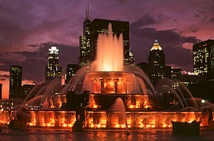
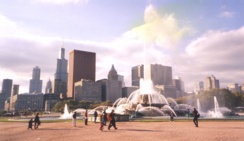
Marcel Francois Loyau (French, 1895-1936), Buckingham Fountain, 1927, Georgia pink marble; the bottom pool's diameter is 280 feet, the lower basin's is 103 feet; the upper basin's is 24 feet; the height of the upper basin is 25 feet above that of the lower basin; altogether 1.5 million gallons of water; 133 jets spray 14,000 gallons of water per minute as high as 135 feet in the air; Grant Park, Chicago, IL. Modeled after the Latona Fountain at Versailles, but twice its size, the Buckingham Fountain is sited just a few feet from Lake Michigan, it was built to celebrate the lake. The four Art Deco style bronze sea horses that surround it symbolize the four states that touch Lake Michigan: Illinois, Indiana, Michigan, and Wisconsin. A computer controls the variations in the spray of the fountain's jets. On summer nights, it is lit by a moving and multi-color light show, also computer controled. Music, added in 1999, is coordinated with some displays. Unable to operate the fountain in Chicago's icy winter weather, in December the city festoons it with glittering white Christmas lights.
![]()

![]()
American, The Dancing Fountains, 1998, Bellagio Casino, Las Vegas, NV.

Kathryn Gustafson (American, 1951-), Diana, Princess of Wales Memorial Fountain, 2004; water flows in an oval ring carved from 545 stones of De Lank granite, quarried in the Mountains of Mourne, County Down, Ireland; 50 x 80 meters; between the Alexandra Gate and the Serpentine, Hyde Park, London. Kathryn Gustafson has said she intends the memorial fountain to sit "like a necklace" around the contours of the site. Its water flows in two directions, and at different speeds. Visitors can wade in the water if they like.
![]() This design was chosen as the result of a competition. The jury noted that the most distinguishing advantage Gustafson's design displayed was its allegorical sympathy with Princess Diana. Gustafson said: "The concept is based upon the qualities of the Princess that were the most loved and cherished. These were inclusiveness and accessibility."
This design was chosen as the result of a competition. The jury noted that the most distinguishing advantage Gustafson's design displayed was its allegorical sympathy with Princess Diana. Gustafson said: "The concept is based upon the qualities of the Princess that were the most loved and cherished. These were inclusiveness and accessibility."
How it works:

 1 Water enters the fountain at its highest point, pumped at 100 litres/second.
1 Water enters the fountain at its highest point, pumped at 100 litres/second.
2 Water traveling east bounces down steps.Here is a portion of this section as it was being fabricated by S McConnell and Sons in Kilkeel, Northern Ireland.
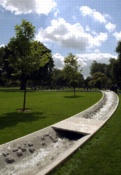 3 The next section was carved to make the water sway gently from side to side.
3 The next section was carved to make the water sway gently from side to side.
4 Water picks up momentum and is invigorated by subtle jets.
5 Water flowing westward — the opposite direction — resembles a babbling brook.
6 Air bubbles are introduced as it approaches a waterfall before entering a water feature created by its flow over carved
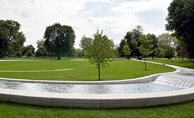 stone.
stone.
7 Final destination: a large, tranquil pool, where water from east and west meet before being pumped through underground pipes to restart the cycle.
Fountains: The World of Water is a resource on the history of fountains of the world offered by garden-fountains.com, an American fountain design and manufacturing business based in California and Maryland.
Also see art
careers, feng shui, and technology.
https://inform.quest/_art
Copyright © 1996-![]()